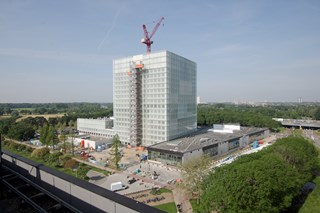Smart panels for labaratories RIVM
June 2021 - Utrecht, The Netherlands
The construction of the new housing for the RIVM and MEB along the A27 in Utrecht is progressing well. The building is expected to be commissioned in 2022. Under the name MEET, Strukton Worksphere has concluded a DBFMO contract with the national government for the design, construction, maintenance and operation of the building for a period of 25 years. MEET has awarded Elektro Internationaal the contract to supply smart distribution panels for the electrical installation for offices and laboratories.
Jeroen Dirkzwager, head of the business office of Elektro Internationaal explains the specifics of the project: “We have experience in supplying energy distribution systems to the pharmaceutical industry. But this project is very special because of the conditions and requirements that apply to the research laboratories. The slightest changes in environmental factors can affect the tests performed in the labs. That is why our focus is (as always) on an uninterrupted power suply. The power must not fail, because that too can have disastrous consequences for the important work of RIVM. The wish is therefore a continuous, problem-free energy distribution. And that is where our expertise lies.’
Selectivity study with circuit breakers
In April 2020, Elektro Internationaal was officially awarded the contract for the required low-voltage components for the electrical installation. Dirkzwager: ’We started engineering together with MEET to come up with the best solution. We have used all our experience and skills to be able to deliver a top product that meets all qualifications. Due to demonstrable advantages, we have converted the original fuse-based design to circuit breakers. Schneider Electric then conducted a new selectivity study. Based on the new design, we started producing the main distributors and the sub-distributors for the building installations. And the panels for the laboratories, which are spread over 5 floors. The floors are each subdivided into 4 quadrants with 10 labs in each. In every lab there will be a low-voltage distribution panel made in our workshop in Woerden.’
Smart panels
Everything about the panels we build is smart. The incoming and outgoing heavier power supplies (including the Masterpacts) of the main distributors can be read via Ethernet for position indication, status and current quality of the breakers and energy consumption. If the use of emergency power should be required and the generator is switched on, the non-preferred groups will be omitted to prevent generator overload. When switching back to transformer operation, those groups switch back on. This is controlled by the smart main distributors via the network.
Signaling and power monitoring
The 215 lab distributors built in the Prisma GK system are smart in more ways than one. First, they are divided into three segments. A non-preferred part that may fail if there is no voltage. Then there is an NKO (emergency short interruption), so a very short interruption after which the generator starts up and takes over the power supply. And a NZKO (emergency without short interruption) that sits behind the UPS. ’By constructing the panels in this way, we guarantee the continuity of the power supply,’ Dirkzwager explains. Secondly, all statuses of the groups of these panels are communicated to the network via PLCs, as well as the kWh measurement. All signals and power monitoring are ultimately made visible in the dashboard that is set up within the EcoXpert platform of Schneider Electric.’
These panels are supplied with power from the main distributors via a Canalis busbar system, which is supplied and installed by Schneider Electric. The 150 junction boxes on the rail are produced by Elektro Internationaal. Dirkzwager: ’The junction boxes feed the sub-distributors and there are again sub-distributors between the sub-distributors and the lab cabinets. Each sub-distributor feeds two quadrants, so we’re supplying a total of 10 of those. These will be built in Schneider Electric Prisma P.”
Typical as a starting point
’Due to the complex layout of the large number of lab panels, we looked at how to gain efficiency in our production process,’ Dirkzwager continues. “We built a typical especially for this. It enabled us to determine the wire lengths, so that all wires could be made in advance. This way we have made the process as lean as possible. And finally, we have already attached the connector cables to the panels, so that they can be easily plugged in by MEET during the last phase of the installation. Smart, lean and fast: this project makes the heart of a modern panel builder beat faster.”
[Image: MEET RIVM]
RETURN TO PROJECT OVERVIEW (https://www.elektro-internationaal.com/tp-28933-2/nieuws/project)
 Elektro Internatonaal_ Nieuwbouw RIVM
Elektro Internatonaal_ Nieuwbouw RIVM